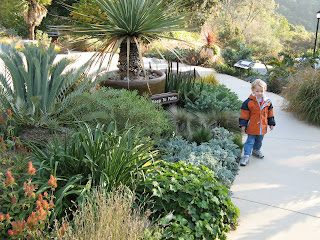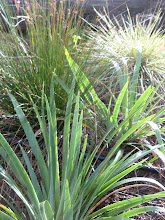I told you I'd be back at the
Potowat Health Village to show you the inside. Here's a quick look at some of the outside first.
Red leaves (Acer glabrum?) and blue green leaves and white berries (Symphoricarpos spp.) make a great combination.
Here's a nice trio: Vine Maple, Giant Chain fern, and that short cultivar of redtwig dogwood.

Beach strawberry (Fragaria chiloensis) is used as a ground cover extensively. A while back I saw them mowing it down, which I'm sure helps keep it dense and low. The larger leaved plant is Garrya eliptica.

There's a creek that runs around most of the building complex, and you can see that it also runs under the complex (it emerges in the courtyard wellness garden).

So I've stepped inside and made a left, through a tall, dark, entry and into this small hallway. Through the window, you can see the wellness garden. (Remember, the garden is completely enveloped by the building.) The banners and canoe remind me of my viking heritage.

Here's a closer view of the garden through the window, and through a young wax myrtle.

So I've stepped outside into the garden and there's the rest of the creek. As far as I can tell, these are all native plants (except for the weeds).

A closer look reveals a diversity of creekside plants, including Darlingtonia, sedges, strawberries, and monkeyflowers.

They have very large, hefty pots along the patio/path areas. I've always liked river rock up against curving concrete. And the irises tucked in here and there are nice. I can see someone's been working on the garden recently. There are less weeds and more mulch.

Here's another view. I think the standing dead trees are brilliant.

Close up of Equistum hymale and strawberry and a bit of water parsley.

Now I'm back inside, on the other side of the building.
 Inside there are many paintings, photographs, and traditional crafts displayed, like these baskets. This place has a completely different feel than other hospitals/health clinics I've been too.
Inside there are many paintings, photographs, and traditional crafts displayed, like these baskets. This place has a completely different feel than other hospitals/health clinics I've been too.
And everywhere in the building there is a view of the garden. Feeling better already.

P.S. This was a stop on my job hunt. No, they aren't hiring a gardener. But don't worry, there are prospects elsewhere.








 Here's the CA native, Coreopsis gigantea, out of its summer dormancy, with some silver Dudleya spp.
Here's the CA native, Coreopsis gigantea, out of its summer dormancy, with some silver Dudleya spp.













































